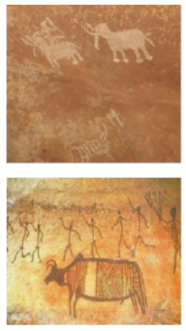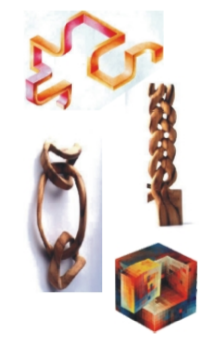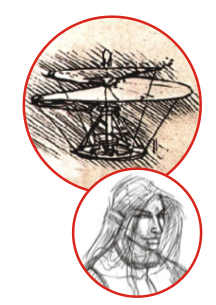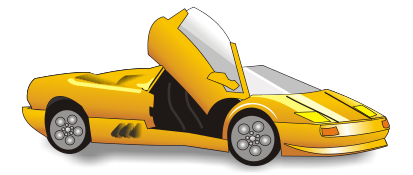Table of Contents
Chapter 2
GRAPHIC ART DESIGN AND GRAPHIC DESIGN
Graphic art and design span the history of humankind from cave paintings to the dazzling neon signs of the modern era. In both its history and in the relatively recent expansions of visual communication in the twenty-first century, there is sometimes a blurring distinction and overlapping relation of advertising art, graphic design and fine art. They share many of the common elements, theories, principles, practices and language. The essence of graphic design lies in representing information, providing form to ideas, expression and feeling and giving shapes to artefacts that document human experience.
GRAPHIC ART
The word 'Graphic' has been derived from the Greek word Graphikos . It stands for writing, drawing (pictorial or symbolic rather than verbal) and 'Art' meaning skill applied to a production of beauty or to a work of creative imagination. In general, the phrase 'graphic art' covers a large number of activities from designing logos to book printing, from symbol designing to artistic print-making, from commercial arts to fine arts. Diagrammatical drawings, signs and symbols either painted or printed are also included under the rubric of 'graphic art', but the phrase is largely used for printing activities. It is possible to trace back the roots of the graphic design in history. Humans always have the desire to communicate and preserve their knowledge, ideas, skills and life experiences for future generations. This drive has revealed itself in many forms. Their first attempts to communicate were through body signs, gestures and symbols. Later on through using words or language, through legends and storytelling; and then by means of some visible form through preserving in caves on stone, carving, engraving, etching and writing on clay, wood, metal , paper or any other available material.
Figure 2.1 Cave paintings, Altamira, Spain
The drawing expressions discovered in 1940 are considered to be the finest and the oldest examples of prehistoric art. Carbon dating suggests that images were created between 15,000 and 17,000 years ago in the caves near Montignac, in the Dordogne region, in south west France. Whereas the earlier pictographic representations are about 5,000 years old while the most recent written language is around 1,000 years old. Similarly, in Europe, the cave drawings in the Altamira cave rocks of Mount Vispieres in Spain have similar artefacts of the Paleolithic Age or Stone Age. All are the significant milestones in the history of graphic design and other fields which have their roots in graphic art.

Figure 2.2 Bhimbetka cave paintings, India
In India Bhimbetka caves surrounded by the northern boundaries of Vindhya mountain ranges near Bhopal have more than 600 caves that have the oldest prehistoric paintings in India. And out of the 24 world heritage sites Bhimbetka caves have been recognised by UNESCO in India, as one of the oldest. These caves had been used as a shelter by people from the earliest periods. Thus, you find paintings of all periods starting from the Paleolithic era to the medieval era. The paintings turn out to be a mirror showing evolution of humanity through time.
These are very old accomplished renderings of animals resting or in action. The depiction shows their draughtsmanship, sense of observation, memory and drawing skills which overrides the limitations of inadequate materials. These were drawn on rough walls of cave rocks. The meaning of some of them remains undiscovered.
Are these, symbols of magical power invoking favourable conditions, through the miracle of creative art?
Are these, drawings of animals to gain power for hunting?
Or perhaps they were primitive artists who had no message to convey but a desire to create?
There are no simple answers to these questions. One thing is for sure that these are the earliest graphic documentation or representations of their experiences. Across all the civilisations of the world, there is ample evidence of graphic practices for documentation and representation of life experiences. However, it was not called graphic design in those days. Historically, graphic design has originated from the art of painting during and after renaissance in Europe. Initially it was called graphic arts. The graphic arts were defined as the fine arts of drawing, painting, engraving, lithography, wood-cut, print-making and printing processes, etc.
Figure 2.3 'Los Caprichos' Aquatint by Goya
During seventeenth and eighteenth centuries, engravers copied the works of other artists. Then the photographic techniques replaced the process of engraving, in printmaking. By and large it denoted reproductive techniques and related processes and artists as well as craftsmen involved in this activity were called graphic artists. Many professional artists, viz. Durer, the first artist to engrave portrait, Lucas
Cranach, used etching and woodcut for reproduction of their works. Rembrandt did more than 300 plates and explored the expressive possibilities of the medium of graphic arts. In the nineteenth century, many of the impressionist and postimpressionist artists such as Goya, Manet, Degas, Renoir, Gauguin used the lithographic process in new and original ways as an aesthetic and expressive medium.
INTRODUCTION TO DESIGN
Design (French- deeseing; Italian-Disegno; Sanskrit- Kalpa, Rachna)
During Renaissance, design was considered as an integral part of painting in Italy when a systematic vocabulary of design was worked out. Around the fifteenth century, the art theorists identified design (disegno), colour (colorito), composition (compositione), and invention (invention) as the four elements of painting.

Figure 2.4 Different designs
During that period, i.e. fifteenth century art critics used to divide design into two parts: disengo interno and disengo esterno. In its wider meaning disengo means a creative idea in the mind of an artist, as this was often thought to be embed ed in initial drawing or conceptual sketch. Thus Baldinucci, an art critic and theoretician, defined design as a visible demonstration by means of lines or sketches on the paper which man first conceived in his mind and picture in the imagination, then hand made them appear on a surface in the form of expression or design.
In seventeenth century, art critics who believed in the philosophy of Socrates and Plato attached certain mystique to the word 'design' due to the analogies drawn between creative activity of the artist and the creation of world by God. Accordingly, the power of design was held to distinguish an artist from the craftsman. On the other hand the art critics and historians who were the followers of Aristotle's philosophy
insisted that design must be based on a careful observation of nature and does not require any mysterious powers.

Figure 2.5 'Transition' graphic print in aquatint medium
In the modern context, usage of the term design in its widest sense denotes the planning of any artefact whether for use or for presentation. In the book titled Nature of Design (1964), David Pye, a twentieth century critic, specified six conditions of design. Firstly, design must follow essential principles of composition or arrangement. Secondly, each part of the design must be geometrically related with each other. Thirdly, the parts of a design must be robust or strong enough. Fourth condition of design is that it should communicate the desired intention or a message to its users or the audience.The fifth condition is that design should avoid the possible unwarranted results or interpretations. Finally, design should be properly accessible by the user or the audience. During this period, theory of functionalism influenced design thinking, which argued that form or the structure of an artefact should follow function. Later a more balanced opinion prevailed which argued that the function of design may act as a guiding principle but not dictate the form or beauty of the design. Thus the term design is used with
special regard to appearance then beauty of the form, style, fashion or trend, etc.
The word 'design' is used in different senses in different contexts. It has a wider meaning as well as a narrower meaning. In a narrower sense it is used as 'graphic design', 'industrial design', 'textile design', or 'fashion design'. In these cases the term 'design' refers to highly specialised creative activity pertaining to these fields. In a wider sense the term 'design' refers to purposeful activities that lead to creation of something significant. The term 'design' is used in different senses in different fields such as circuit design in electronics, design of a building in architecture and design of a logo in graphic design.
Commonly the term 'design' is used as a noun to refer some object or a pattern which is beautiful and/or useful. It can be a sketch of an idea, a concept or a thought. For example design of a washing machine, design of a car or design of a futuristic car. It also refers to a beautiful pattern on the shirt, sari or a cloth in the same sense.
As a noun the word 'design' is used in the following ways
'Design' as a drawing or a preliminary sketch.
Design' as a graphic representation, especially a detailed plan for construction or manufacturing, such as an architectural
plan of a building.
'Design' as a purposeful or inventive arrangement of parts or details as elegant design of an aeroplane.
'Design' as a decorative or an artistic work or an ornamental pattern.

Figure 2.6 Drawings of different objects
The word 'design' is also used in another sense as a verb to refer to a process or an activity that results into a design. The process of designing involves a series of activities that finally leads to a product or an artefact. This process or activity of designing can be a mental process and/or a physical process of making artefacts or objects of design. The process can also involve a group of people, system or entire organisation. Thus, the process of design can be an individual process as well as a group process.
The word 'design' is used as a verb to denote some activity in the following sense
'To design' means to conceive or fashion in the mind such as 'visualising' a futuristic car or an aeroplane.
'To design' means 'to innovate or invent' something new such as a new type of mobile phone.
'To design' means 'to formulate a plan' for an event or making arrangements for a function in a planned and systematic manner.
'To design' means 'to devise a strategy' for launching a new product in the market.
'To design' means 'to have as a goal or purpose' or an intention such as to design a vehicle that will not cause pollution.
' To design' means 'to create or execute' in an artistic or highly skilled manner for example creating an artwork for an advertisement.
Figure 2.7 A textile design
Thus, the term design as a noun as well as a verb has many meanings and usages in different contexts. The word design is used to refer to the process as well as the output of the process. Now you must have realised that when a concept is created and you are engaged in the process of developing an idea - design as a verb, as well as you are creating beautiful patterns/design on your creation - design as a noun and also finally there is a new design of a concept at the end.

Figure 2.8 Architectural layout design of a house
Broadly, design involves two stages: the first stage is a mental activity of imagination, visualisation and generation of new concepts or ideas. The second stage is the stage of manifesting or articulating these ideas using some medium of expression and/or communication. When an idea is generated in the mind, it is in an abstract form. Then at the second stage it is articulated in some form which is perceivable or understandable. One can draw a sketch of the concept, write it down on a piece of paper, act it out or express through gestures and so on and so forth. The first stage is termed as 'disengo interno' (generation of mental image or an idea) and the second stage is called 'disengo estreno ' (externalisation of the mental image or idea into a physical form). Therefore, the simplest definition of design would be as follows:
Design is a purposeful or intentional activity to generate concepts or ideas which are new in some sense and manifest or represent them. The output of this activity is also termed as design.

Figure 2.9 User friendly gadget design includes design of the whole gadget as well as user friendly graphic images and typography on it.
INTRODUCTION TO GRAPHIC DESIGN
Graphic design differs from graphic arts because graphic design is goal oriented while graphic art is not. That is why graphic design comes under the rubric of 'design'. Secondly, graphic design activity is always concerned about target user or target audience and attempts to fulfil user requirements. On the other hand, graphic art activity is not practised keeping the user in mind. Graphic art is practised for its own sake as well as for pursuing a higher aesthetic experience.

Figure 2.10 A modern motor vehicle
Figure 2.11 Solar energy vehicle
Graphic design involves the process of transformation of the mental concept into actual form through specific medium which is called representation. The activity of representation is the crux of graphic design.
Graphic design spans over but not limited to the activities mentioned below:
Design of logos, graphics, letterheads, brochures, newsletters, posters, signs, advertisements and any other type of visual communication.
Combining text and graphics to communicate an effective message.
Representation, decoration, and writing or printing on two-dimensional and three-dimensional surfaces.
Techniques and crafts associated with drawing, engraving, etching and lithography, photography, serigraphy and woodcut.
Printing and bookmaking of all types for publications.
Design for various media, such as print, digital media, motion pictures, animation, product decoration, packaging and so on.

Figure 2.12 Structural design
Philip Meggs, a noted historian of graphic design defines graphic design in his classical book History og Graphic Design. He looks at graphic design from a historical point of view as follows:
"Since prehistoric times, people have searched for ways to give visual form to ideas and concepts, to store knowledge in graphic form, and to bring order and clarity to information. Over the course of history, these needs have been filled by various people including scribes, printers, and artists. It was not until 1922, when the outstanding book designer William Addison Dwiggins coined the term 'graphic design' to describe his activities as an individual who brought structural order and visual form to printed communications, that an emerging profession received an appropriate name."

Figure 2.13 Letterhead design
Thus, it appears that the term graphic design was used in the context of book design and printing. However, prime motivation for graphic design activity was towards representing ideas and concepts for better communication and preservation. Graphic design achieves the task of representation of ideas and concepts in an elegant and aesthetically acceptable way.
Graphic design has a remarkable impact on individuals, society and culture in general. Starting from prehistoric cave paintings to the modern age, elements and concepts of graphic design are used to express, communicate or promote and provoke. We can see plenty of examples throughout the history of mankind where ideas, expressions, experiences, perceptions and stories are depicted through visual language.

Figure 2.14 Logo design
History of Graphic Design Graphic design has always contributed and impacted society in a constructive way. It helps people for clear and imaginative visual communication to relate people with people, cultures, economies and social lives. Graphic design helps shape messages and images which create awareness about environment and society. Therefore, a simple definition of graphic design would be as follows: Graphic design is a purposeful activity of representation and communication of information in simple and effective ways. It involves processes of imagination and visualisation for generating ideas and represent them through the medium of visual perception by using visual language of basic elements, viz., dot, line, colour, texture, shape, form, two-dimensional and three-dimensional space, typefaces and principles of visual language, viz., balance, rhythm, proportion, symmetry, contrast and harmony.
Exercises
1. What is the difference between graphic art and graphic design? Explain by giving your own examples.
2. What is 'Design' ? Elaborate on David Pye's concepts of design by using examples of graphic design.
3. Define 'graphic design' in your own language.
Practicals
Design an invitation card for a school festival/annual day/sports day.



